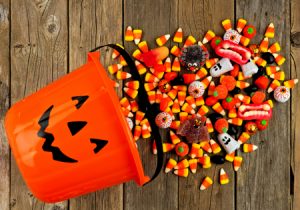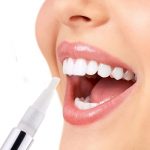
With Halloween comes ghosts, goblins and goodies — and the sugar in those treats can play unwanted tricks on your teeth and dental restorations if you’re not careful.
 Here’s why: The bacteria in your mouth are more excited to eat Halloween candy than you are. When bacteria zones in on the sugar and leftover food in your mouth, a weakening acid is produced. That acid is what can contribute to cavities.
Here’s why: The bacteria in your mouth are more excited to eat Halloween candy than you are. When bacteria zones in on the sugar and leftover food in your mouth, a weakening acid is produced. That acid is what can contribute to cavities.
Don’t hang up that costume just yet. Halloween is a fun day for all – young and old. Think of eating your candy as a splurge, just be sure to rinse, brush and floss after treating yourself. When parents and children are sorting through the pillow cases filled to the brim and loot bags, we want to remind you of some common candies that may cause havoc on your teeth:
- Chocolate is probably your best bet, which is good because it’s also one of the most popular kinds of candy handed out on Halloween. Chocolates are often soft, and easily dissolve.
- Sticky and Gummy Candies – ‘Be picky, if it’s sticky.’ These are some of the worst types of candies for your teeth. The candy is harder to remove and stays longer on your teeth, which gives cavity-causing bacteria more time to work.
- Hard candy can actually break your teeth if you’re not careful. We tend to keep these candies in our mouths for longer periods of time, so the sugar gets in your saliva and washing over our teeth for longer periods of time.
- Sour Candy may make you pucker, especially if they are sticky and coated in sugar. Sour candy can be very acidic, and can weaken and damage the hard outer shell of your teeth, making your teeth more vulnerable to cavities.
Whatever the cuplrit, Dr. Malcomson recommends brushing, flossing and continued oral hygiene through regularly scheduled dental visits.
Wishing you all a Happy and Safe Halloween!



